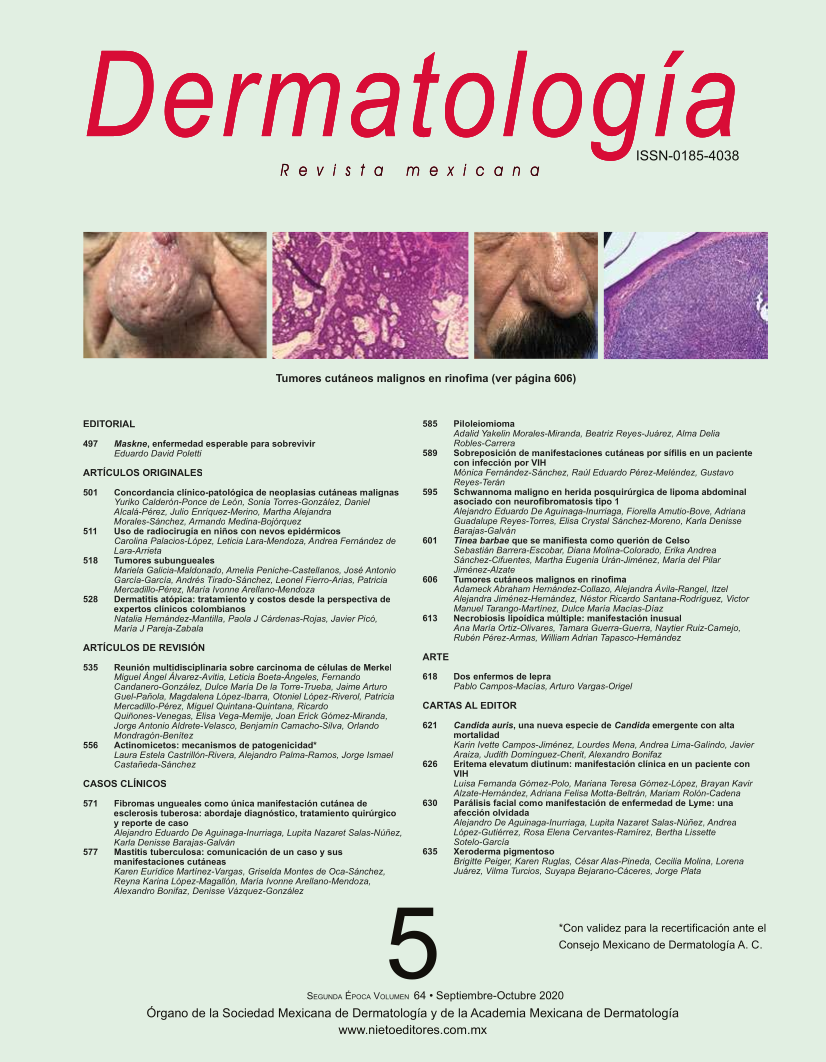Tuberculous mastitis: A case report and its cutaneous manifestations.
Dermatol Rev Mex. 2020; 64 (5): 577-584.
Karen Eurídice Martínez-Vargas,1 Griselda Montes de Oca-Sánchez,2 Reyna Karina López-Magallón,3 María Ivonne Arellano-Mendoza,4 Alexandro Bonifaz,5 Denisse Vázquez-González6
1 Residente de primer año de Dermatología.
2 Dermatóloga adscrita al Servicio de Dermatología.
3 Residente de tercer año de Anatomía patológica.
4 Dermatooncóloga. Jefa del Servicio de Dermatología.
5 Servicio de Dermatología y Departamento de Micología.
6 Dermatóloga adscrita al Servicio de Dermatología.
Hospital General de México Dr. Eduardo Liceaga, Ciudad de México.
Resumen
ANTECEDENTES: La mastitis tuberculosa es una forma rara de manifestación extrapulmonar, incluso en regiones endémicas. Afecta principalmente a mujeres en edad reproductiva, se manifiesta con un nódulo mamario, pocas veces doloroso, que puede confundirse con un absceso o carcinoma mamario. La citología por aspiración con aguja fina se ha convertido en la primera opción como herramienta diagnóstica en el estudio de lesiones mamarias, lo que permite iniciar el abordaje.
CASO CLÍNICO: Paciente femenina de 36 años de edad, quien padecía dos dermatosis: una localizada, unilateral y asimétrica, que afectaba el tronco anterior en la mama izquierda, constituida por eritema, área de induración con tres lesiones nodulares, mamelonadas y trayectos fistulosos, con costras sanguíneas y melicéricas, escaso exudado sero-purulento y dolor a la palpación. La otra dermatosis era localizada, bilateral y simétrica, afectaba ambas extremidades inferiores en su cara antero-lateral. Estaba constituida por múltiples nudosidades y algunas manchas hipercrómicas. Tenían una semana de evolución y eran dolorosas. El estudio histopatológico mostró lesión en la dermis y reticular, conformando una reacción inflamatoria granulomatosa, constituida por infiltrado inflamatorio difuso, compuesto por linfocitos, fibroblastos, macrófagos y células gigantes multinucleadas.
CONCLUSIONES: No obstante la rareza de la mastitis tuberculosa, ésta debe considerarse ante una lesión mamaria con nódulos o abscesos con o sin fístulas que muestren poca o nula respuesta al tratamiento antibiótico convencional.
PALABRAS CLAVE: Mama; tuberculosis; Mycobacterium tuberculosis; mastitis; tuberculosis extrapulmonar.
Abstract
BACKGROUND: A tuberculous mastitis is a rare form of extrapulmonary presentation, even in endemic regions. It mainly affects women of reproductive age, presenting a breast nodule, rarely painful, that can be confused with an abscess or breast carcinoma. Fine needle aspiration cytology has become the first option as a diagnostic tool in the study of breast lesions, allowing the approach to be conducted.
CLINICAL CASE: A 36-year-old female patient, who suffered from two dermatoses: one localized, unilateral and asymmetric, which affected the anterior trunk in the left breast, consisting of erythema, area of induration with three nodular lesions, mamelonated and fistulous tracts, with blood and meliceric crusts, little sero-purulent exudate and tenderness. The other dermatosis was localized, bilateral and symmetrical, affecting the lower extremities on its anterolateral region. It consisted of multiple nodes and some hyperchromic spots. They had a week of evolution and were painful. Histopathological study resulted in lesion in the dermis and reticular, forming a granulomatous inflammatory reaction, consisting of a diffuse inflammatory infiltrate, composed of lymphocytes, fibroblasts, macrophages, and multinucleated giant cells.
CONCLUSIONS: Although tuberculosis mastitis is rare, it must be considered before a breast lesion with nodules or abscesses with or without fistulas that show little or no response to conventional antibiotic treatment.
KEYWORDS: Breast; Tuberculosis; Mycobacterium tuberculosis; Mastitis; Extrapulmonary tuberculosis.

